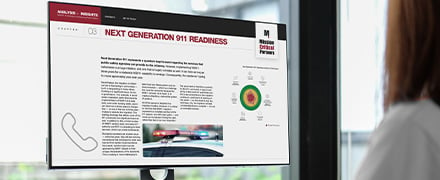D.C. Develops an Interesting Approach to Triaging Low-Acuity 911 Calls
Posted on April 20, 2018 by Jeff Wobbleton
An epidemic is afflicting the entire United States. It involves low-acuity emergency calls to 911 call centers that are overburdening the emergency medical services (EMS) provided by municipal governments. This burden is even extending to the emergency rooms (ERs) to which these patients are transported. The result is that emergency medical technicians (EMTs) increasingly are suffering from stress and morale issues, ambulances are falling into disrepair, and ERs are struggling to keep up with the demand.
Low-acuity calls are those that do not qualify as Basic Life Support (BLS) or Advanced Life Support (ALS) incidents, such as sprains, the flu, a cut requiring stitches, stomach cramps and the like. The problem is that when someone dials 911, the municipality is obligated to dispatch an ambulance/EMT/paramedic to the incident to assess the patient’s condition and, given some patient bill of rights, transport the patient to an ER. This is required regardless of the severity of the incident, even for low-acuity calls, which require neither a visit from EMTs or transport to an ER.
Often, the 911 caller truly believes that they are having a medical emergency. Occasionally, however, there are times when the caller may be abusing the emergency communications service to get a quicker response to their non-emergency. One incident in particular, a woman called 911 to report chest pains. When the EMTs arrived, they were asked to wait while she applied makeup. This clearly was not an urgent situation—the caller simply wanted transportation to the medical facility. There are even times when an individual in a healthcare facility has called 911 to get transported to another healthcare facility because they thought the wait time at the first facility was too long or the service was “unacceptable.”Regardless of how it happens, a lot of people end up in ambulances and ERs that do not belong there.
Some municipalities combat this in one of two ways. One approach is to get out of the ambulance business altogether because of its high cost and contracting instead with third-party ambulance services. The other approach is a hybrid solution. The municipality still dispatches its EMTs and ambulance when an emergency call is received by the 911 centers, but the EMTs, after triaging and stabilizing the patient, if necessary, will call for a third-party provider to provide transport for BLS and low-acuity calls. In both approaches EMTs/paramedics no longer need to standby while ER staff execute the patient handoff and assume responsibility for their care—this now is handled by another party—freeing up ambulances and staff. Yet these fixes do little to help ERs, which still are overburdened by low-acuity patients that really should be getting healthcare in another non-emergency setting.
A New System in D.C. that Integrates the Healthcare System with 911 and Emergency Response
The District of Columbia has a bolder approach, dubbed “Right Care, Right Now,” that seeks to address the issues head on. It is launching a pilot program this month dubbed the Nurse Triage Line (NTL), which is intended to integrate the healthcare system with 911/emergency response. The NTL will be administered by American Medical Response (AMR), a third-party provider of ambulance, medical evacuation and other health-related services throughout the Washington, D.C., region.
Here’s how it works: When a 911 call is placed, it first will be fielded by a 911 telecommunicator using prescribed protocols to determine whether the medical call, based on established criteria, qualifies for further discussion with the NTL registered nurse. If so, the call then will be transferred to the NTL nurse, who will ask the caller another series of protocol-based questions. Depending on the answers, the NTL nurse will determine the appropriate medical care for the caller. In some instances, the NTL nurse will work with the patient to schedule a visit with his/her primary care physician and arrange transport via a taxi or ride-sharing service, or a family member. If it is determined that the caller should be given immediate care, the call will be transferred back to the appropriate 911 center, where a telecommunicator will dispatch an ambulance and any other appropriate response.
The District isn’t expecting much pushback from 911 callers, based on a recent consumer survey that revealed the following:
- Eighty percent of respondents indicated that they would be comfortable with speaking to a nurse over the phone.
- Seventy-eight percent of respondents indicated that they would speak on the phone with a nurse for 10 minutes or more.
- Ninety percent of respondents indicated that they would agree to be transported to a healthcare facility other than an ER, if the nurse arranged it.
A Win-Win From All Angles
Here at Mission Critical Partners, in this year that marks the 50th anniversary of 911 service in the United States, we have launched a campaign entitled, “Let’s Evolve 911,” and the District of Columbia’s NTL pilot project aligns perfectly with that theme. This program has the potential to have a profound impact on emergency response. It will reduce the number of calls that are handled by EMTs, freeing them to handle true emergencies, while reducing their stress and improving their morale. Ambulances will not be overtaxed—at least not as much—and will be better maintained because they will not constantly be on the street, responding to calls that could be handled with non-emergency medical resources. Finally, and perhaps most importantly, ERs won’t be as overrun as they are today, which should enable them to enhance the level of care provided to BLS/ALS patients.
This program is expected to have a transformative effect on D.C.’s 911 center. Eventually the day will come, assuming that the D.C. pilot project has legs, when 911 centers across the U.S. also will consider how integrated healthcare services—such as a nurse triage line and telemedicine processes—can enhance their ability to provide optimal care to emergency callers, a prospect that aligns well with the “Let’s Evolve 911” paradigm.
PSAPs that are interested in investigating whether D.C.'s new model of integrating public healthcare systems into 911 operations to provide better care for patients would be beneficial for their agency could partner with MCP to study their operational processes, or embark upon a staffing study.
As one of the architects of the District’s NTL pilot project, I would love to speak with 911 officials about developing such a program for their municipalities—let’s evolve 911, together.
Topics: Operations, Staffing, 911 Anniversary







